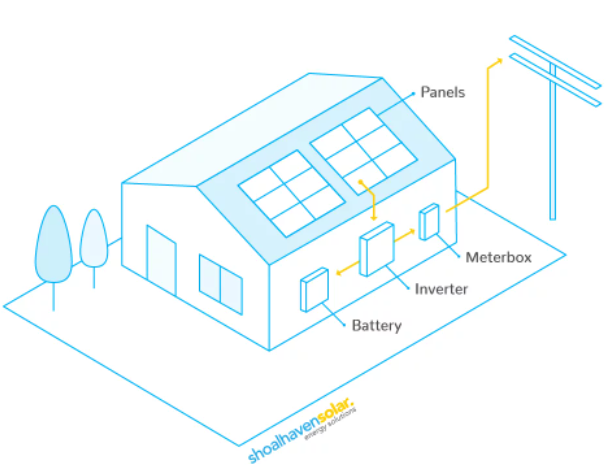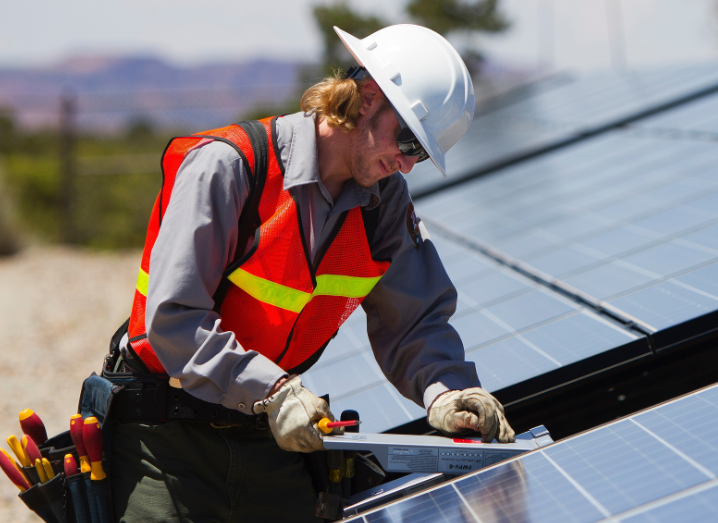Did you know that you can power your house using solar energy, even when the sun is not shining No, you will not pay to use electricity from the sun. Once a system is installed, you are good to go. You stand to gain several folds with the right energy storage.
Yes, you can use solar to operate all the electrical appliances in your house. You will not even notice the difference between solar and grid electricity. That is how efficient it is, despite being low cost.
All of that, and more, is possible because of solar battery storage.
How do solar batteries work?
Solar batteries work by storing excess energy from the sun to use later whenever the need arises. This energy is in the form of DC electricity. It is generated by solar panels and is part of a more extensive home energy system.
The stored energy is then used to power up the home long after sunset.
A solar power system comprises several components. Here are the most vital elements.
The solar panels (or solar photovoltaic cell panels) collect sunlight. These cells then convert it into electricity; (Direct Current).
A solar inverter converts the Direct Current to Alternate Current. This is so that it is compatible with home lighting, electronics, and electrical appliances.
A switch box receives, regulates, and redirects the AC electricity to where it is needed.
A regulator directs the DC to the battery. It also ensures that the battery does not overcharge.
A bi-directional utility meter is necessary if your home is connected to the grid. It records the electricity that you are taking from and sending back to the grid. The records are essential when claiming energy rebates.
A solar battery stores excess energy for use at night or when the sun is not shining.
NOTE: A home solar energy system can work without energy storage. If your home is connected to the grid, the excess energy can be sent back to the grid through the utility meter.
A solar battery allows you to store the excess electricity generated from sunlight, which allows you to use considerably less grid electricity. If you are looking to save a lot more on energy costs than you would be sending excess energy back to the grid, you need a battery.
How does solar work with a battery?
The vast majority of solar-powered systems are connected to the grid. Some of these systems don’t have home energy storage.
When solar energy storage is introduced into the system, it comes with a few changes. The exact changes are dependent on the energy system installed in the home.
Hybrid solar systems connected to the grid
If your home is connected to the grid, it means that your energy may come from solar power, the grid or both. A smart solar inverter is harmonious with the grid. It ensures that the home uses solar power before it taps into the grid’s power.
There are gloomy days when the home’s energy needs may surpass what the solar system can provide. On such occasions, the inverter draws all the solar power and supplements the demand with grid power.
There are days when solar power surpasses the home’s power needs. In that case, the excess solar energy is either stored in a solar battery or sent to the grid.
If you have a solar battery, and there’s still excess power once the battery is fully charged, the extra can be sent to the grid.
Grid electricity costs about 15 to 40c for every kWh while solar is free.
A typical household can save up to 70% of their energy bills when using solar. The amount of energy a home offsets is dependent on the energy needed and the electricity generated from the solar system.
Solar systems that are not connected to the grid
Off-grid solar systems rely on solar power alone. This option is gaining popularity with new constructions, especially in the rural areas, because grid connections can cost up to $50,000.
The upfront solar and battery system installation can be hefty, costing a minimum of $25,000. However, once the installation is done homeowners will not pay to use the sun’s energy for as long as the system is functional.
A solar power system comprises several components. Here are the most vital elements.
The solar panels (or solar photovoltaic cell panels) collect sunlight. These cells then convert it into electricity; (Direct Current).
A solar inverter converts the Direct Current to Alternate Current. This is so that it is compatible with home lighting, electronics, and electrical appliances.
A switch box receives, regulates, and redirects the AC electricity to where it is needed.
A regulator directs the DC to the battery. It also ensures that the battery does not overcharge.
A bi-directional utility meter is necessary if your home is connected to the grid. It records the electricity that you are taking from and sending back to the grid. The records are essential when claiming energy rebates.
A solar battery stores excess energy for use at night or when the sun is not shining.
NOTE: A home solar energy system can work without energy storage. If your home is connected to the grid, the excess energy can be sent back to the grid through the utility meter.
A solar battery allows you to store the excess electricity generated from sunlight, which allows you to use considerably less grid electricity. If you are looking to save a lot more on energy costs than you would be sending excess energy back to the grid, you need a battery.
How does solar work with a battery?
The vast majority of solar-powered systems are connected to the grid. Some of these systems don’t have home energy storage.
When solar energy storage is introduced into the system, it comes with a few changes. The exact changes are dependent on the energy system installed in the home.
Hybrid solar systems connected to the grid
If your home is connected to the grid, it means that your energy may come from solar power, the grid or both. A smart solar inverter is harmonious with the grid. It ensures that the home uses solar power before it taps into the grid’s power.
There are gloomy days when the home’s energy needs may surpass what the solar system can provide. On such occasions, the inverter draws all the solar power and supplements the demand with grid power.
There are days when solar power surpasses the home’s power needs. In that case, the excess solar energy is either stored in a solar battery or sent to the grid.
If you have a solar battery, and there’s still excess power once the battery is fully charged, the extra can be sent to the grid.
Grid electricity costs about 15 to 40c for every kWh while solar is free.
A typical household can save up to 70% of their energy bills when using solar. The amount of energy a home offsets is dependent on the energy needed and the electricity generated from the solar system.
Solar systems that are not connected to the grid
Off-grid solar systems rely on solar power alone. This option is gaining popularity with new constructions, especially in the rural areas, because grid connections can cost up to $50,000.
The upfront solar and battery system installation can be hefty, costing a minimum of $25,000. However, once the installation is done homeowners will not pay to use the sun’s energy for as long as the system is functional.
Post time: Jun-28-2022







